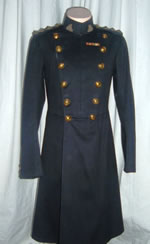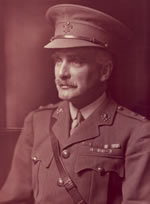Museum of the Manchester Regiment Object Focus
Frock Coat worn by Captain Dorling
 Francis Holland Dorling wore this coat when he held the rank of Captain (c.1901-1913). The medal ribbons on his left breast are those awarded for service in the Boer War (1899-1902) and represent the Queen’s South Africa Medal and the King’s South Africa Medal.
Francis Holland Dorling wore this coat when he held the rank of Captain (c.1901-1913). The medal ribbons on his left breast are those awarded for service in the Boer War (1899-1902) and represent the Queen’s South Africa Medal and the King’s South Africa Medal.
Francis Dorling was born on 11th April 1877, the eldest son of Colonel Francis Dorling of the 96th Regiment of Foot. He was educated at Haileybury College and commissioned into The Manchester Regiment on 8th September 1897 and posted to the 2nd Battalion. He was promoted to Lieutenant on 17th August 1898 and to Captain on 5th January 1901.
Francis served in Aden and then in the South African War as Brigade Signalling Officer to the 17th Brigade and took part in the operations resulting in the surrender of Boer Forces in the Caledon Valley on 1st August 1900.
He was a Company Officer at Sandhurst between 1906 and 1910, followed by Staff College during the First World War. He was awarded the Distinguished Service Order (DSO) and Mentioned in Despatches five times. During the First World War Francis rose to the rank of Lieutenant Colonel.
 He rejoined the 1st Battalion in 1920 as Second in Command, becoming Commanding Officer between September 1920 and September 1922. During this period he was responsible for obtaining official recognition of the Fleur de Lys as the regimental cap badge. Francis served as the Colonel of the Regiment from 1st July 1934 until 11th April 1947.
He rejoined the 1st Battalion in 1920 as Second in Command, becoming Commanding Officer between September 1920 and September 1922. During this period he was responsible for obtaining official recognition of the Fleur de Lys as the regimental cap badge. Francis served as the Colonel of the Regiment from 1st July 1934 until 11th April 1947.
He was instrumental in the establishment of the Central Committee of the Regiment, the Regimental Chapel in Manchester Cathedral and the Regimental Museum in Ladysmith Barracks, Ashton-under-Lyne. Francis died on 15th October 1951.

